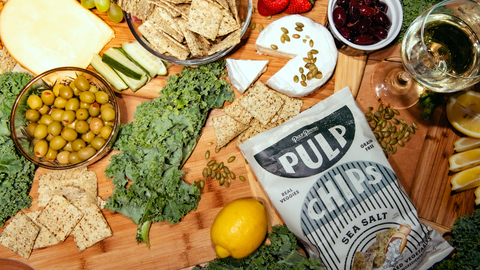
Passionate about reducing food waste, and living more sustainably? Or just worried about the money you're literally throwing in the trash when food goes to waste? We're sharing our top 10 tips to reduce food waste at home.
But first, a little background about why this is such an important topic today.
Food waste is a global issue
The Food and Agriculture Organization of the United Nations (FAO) estimates that globally, one-third of all food produced for human consumption (around 1.3 billion tons) is lost or wasted. In the United States, we’re wasting more than the average, with nearly 40% of our annual food supply going to waste.
And we’re paying the price. According to the FAO, the global cost of food waste is $2.6 trillion per year (!), which includes $700 billion in environmental costs and $900 billion in social costs.
Food waste is a global issue with global consequences, although the reasons why food waste occurs vary from country to country.
Who causes food waste?
Which country wastes the most food? By far, Europe and North America contribute to the most food waste per capita. And most waste is happening at the retail and consumer level (eek!). That’s why it’s important that we take the steps individually to change the course.
Where food waste occurs
In countries like the U.S., with a relatively high income, more waste that occurs at the end of the supply chain with retailers and household consumers.
It’s estimated that in Europe and North America, consumers individually contribute over 200 pounds of food waste each year (that’s per person!). We waste more food as consumers in the United States than any other country in the world.
When we waste food we waste money
How much money do we lose when we waste food? A study at UC Davis estimates that US consumers alone lose $390 per person per year or $1.07 each day on wasted food. For a family of four, that number jumps to $1,500 annually. In the US, we’re spending nearly 10% of our individual food budget on food that goes to waste, 1% of the average disposable income.
But if you think those estimates seem pretty low, well, you just might be right. Some estimates say that we grossly underestimate the amount of waste produced at the consumer level. Sources like PLOS One cite that we might waste as much as 1500 calories, per day, PER PERSON (!) in the United States. Globally, we may be wasting as much as 25% of the calories available for human consumption.
Why food waste happens
In the United States, food waste happens when we reject food based on its cosmetic appearance, or when we order, buy, and serve more food than we can actually eat.
If we reduced food waste by just 15%, we could feed more than 25 million Americans every year (NRDC).
What foods are going to waste?
According to the FAO, we waste 45% of all fruit and vegetables, 35% of fish and seafood, 30% of cereals, 20% of dairy products, and 20% of meat.
Where food waste goes (hint: the landfill)
In the United States, food waste is the top single item sent to the landfills and incinerators (accounting for about 22% of total landfill volume). In cities, less than 2 percent of the nutrients in food by-products are recovered and put to better use. Across the board, 95% of food waste goes straight to the landfill. You read that right, 95 percent! 😧
When food degrades in the landfill, it produces methane, a significant greenhouse gas. Methane is especially potent as a climate change accelerant, another way that food waste contributes to climate change. Food waste is responsible for 8% of global greenhouse gas emissions: it’s the third-largest global greenhouse emitter in the world behind China and the United States.
The Good News: each of us can prevent food waste at home and make a big impact.
Now for our favorite part: 7 Ways that You Can Reduce Waste At Home (and save money!) starting today.

1. Prevent food waste by meal prepping
Did you shop for a specific recipe? If you purchase more food than the recipe calls for, prep your meals for the rest of the week by doubling the recipe to use more ingredients. Don’t let food go to waste because of an ambitious trip to the grocery store. Another pro tip, right when you get home from the store, wash, and prep your items so they’re ready to use or cook when you’re in a pinch. I always have chopped or minced herbs, garlic, and onions ready to use, pre-cut cabbage, pre-riced cauliflower, and broccoli, etc.

2. Store food with these hacks
Water-loving produce - like carrots, celery, cucumbers - slice them up so they’re ready for snacking, and put them in a mason jar or Tupperware full of water so they stay nice and crisp.
Leafy greens and vegetables with thin, fleshy skins like tomatoes last longer when they’re kept in a container that allows them to maintain their moisture. I keep them wrapped up with a thick cloth or in a Tupperware with a moist clean towel.
Herbs, spring onions, and even carrots and celery can all be stored with their tips in water to stay fresher, longer. Make sure to change out the water every day to keep them fresh.

3. Keep a folder of go-to catch-all recipes
Here are our go-to recipes that help fight food waste at home. Keep a few easy favorites (like a go-to veggie or herb hummus/dip, veggie stock, or pesto) in an easy note or bookmark on your phone so that you can always jump on it when your food is on its last leg.

4. Befriend your freezer
Your freezer is your best friend! If you know you’re not going to be able to eat all of your food for the week, freeze it for later use in a smoothie or stir fry. Some examples of foods we love to freeze: cauliflower stalks and stems can be riced ahead of time to throw in the stir fry pot or add to smoothies, frozen fruit chunks for smoothies or desserts, wilted greens, chopped carrots, and zucchini can be frozen for use in smoothies or stir fry. See all of the different kinds of ways that you can store frozen veggies to use in smoothies here.

5. Save food for later use with these kitchen hacks
Frozen herbs in olive oil? This is just one simple way that you can store your food for later, quick use. How about microwave-dried herbs, veggies, or fruit? We’ve compiled some of our favorite quick kitchen hacks here.

6. Use your scraps
Think items like juice pulp should go to waste? Stalks or stems? Peels and skins? Think again! There are so many ways to use your scraps. Check out our favorite recipes here. Prep your scraps ahead of time, either chopping, shredding, or freezing them for future use. Add rinds, peels, and more to oils or liquor to make gourmet ready to level up your cooking and cocktail mixing.

7. If you can’t feed yourself, feed the soils
Where to dispose of food waste responsibly, if it happens? You can easily compost your food waste at your local farmer’s market, a compost hub, or home. Make compost at home and get rich, fresh soil to plant and grow your own veggies from your kitchen scraps! You can easily compost at home by digging a hole in the ground - a method called trench composting - if you’re worried about upkeep.
Why food waste is a problem
Is food waste bad for the environment? A resounding, yes! Food waste matters for the environment, our resources, our wildlife, our economy, and our communities.
By wasting less food at home, we're helping align global goals to reduce food waste by 50% by 2025. That's a huge number, and we're not going to get there without collective solutions at home.
Visit our blog post here for more information about why food waste is a problem.
Explore more of our related blog topics, and sign up to our newsletter for more tips & tricks like this!

About Pulp Pantry:
Pulp Pantry turns overlooked resources like upcycled vegetable juice pulp into wholesome everyday snacks that make it convenient and delicious to eat more servings of vegetables and fiber.
Our newly launched Pulp Chips are vegetable-based, tortilla style chips made from fresh, upcycled vegetables as the first ingredient. Pulp Chips are a craveable better-for-you, better-for-the-planet snack with up to a full day's serving of fiber in each bag.
Try all of our four delicious flavors: Barbecue, Jalapeño Lime, Classic Sea Salt, Salt n' Vinegar.





